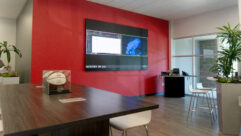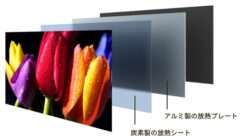
Sharp NoteVision PG-F320W
Dec 1, 2007 12:00 PM,
By Jeff Sauer
Widescreen business projector moves popular trend forward.

One of the clear trends over the last couple of years, as illustrated by Sound & Video Contractor‘s annual Projector Buyers’ Guide, is the move toward native widescreen projectors. That has a lot to do with increasing awareness and interest in HDTV at the consumer level, as well as better-quality motion video images from both home theater and professional projectors. But wide isn’t just for motion entertainment anymore. Business-oriented projectors, such as Sharp’s new NoteVision PG-F320W, are also getting into the act.
The PG-F320W is the first native widescreen DLP business projector with Texas Instruments BrilliantColor technology. It features business-level brightness, LAN connectivity for remote administration, business security features, and automatic setup features that should all appeal to corporate users. And it’s wide.
That trend toward widescreen shouldn’t be too surprising given the preponderance of widescreen flatpanels now at the center of public consciousness. Today, widescreen flatpanels are as commonplace in airports and atriums as in American living rooms, and they’re showing up in conference rooms, too. And while wide laptop computers still make up a relatively small part of that market, it is a segment that is growing in caché and volume. Once you’re used to it, it’s hard to give up the extra desktop space afforded by widescreens, and now the PG-F320W expands that surface area to the presentation screen.
One look at the F320W’s back panel is enough to show that this is a business projector and not a home theater or video-oriented unit. It has only composite video and S-Video ports, but it does have DVI-I and 15-pin RGB in and out ports. More than that, it has an RJ-45 connector for remote administration over a network and via a web browser interface. Sharp has been one of the leaders in remote network administration going back a decade, and it offers a software-administration utility for controlling multiple projectors as a free download.
Auto-keystone correction will help with fast setup if the PG-F320W moves from room to room, although at 9.1lbs. and with a LAN connection, you’d expect it to be installed in one place. On the other hand, Sharp has included a help section in the onscreen menus that offers basic troubleshooting advice for novices (check the cables, check the brightness and color settings, etc.) who are trying to get the unit up and running.
SQUEEZE ME OR SQUEEZE ME NOT
While it’s obviously cool to be widescreen, it should be just as obvious that not all sources will be. The vast majority of content delivered to any business projector will be in a 4:3 aspect ratio, and it probably will continue that way for several years to come. That can make scaling a hugely important feature for a non-standard resolution such as the PG-F320W’s 1280×800.
Happily, Sharp has several aspect-ratio settings to help display images appropriately. In the default mode, images are resized to occupy the entire screen. Both 16:9 and 4:3 images are stretched to fit the 16:10 pixel ratio of the projector, and with fairly good results. Small text and numbers are rendered with noticeable distortion, although 1:1-pixel test patterns reveal the expected high-frequency banding. For example, 1024×768 or 1280×768 source resolutions need to be scaled 4 percent horizontally, and that’s impossible on a pixel-by-pixel basis without fudging a little. Still, widescreen mode is likely what the majority of users will always use, regardless of source resolution, because wide is trendy. And, frankly, who can tell the difference with most presentation slides?
However, those with a more critical eye will favor Sharp’s Dot By Dot mode, which does no scaling at all. 1280×768 images are displayed using just that many pixels (thus leaving 32 horizontal pixel lines black) in the proper aspect ratio. The same is true for 1024×768 or any other size image, thereby leaving black around the image on all sides. And 1280×1024 images? Those are cropped horizontally with only the center 800 pixels visible, but with no scaling involved, the images are perfectly crisp.
Not a video projector, the F320W’s image-processing Achilles heel seems to be with interlaced video. There is a noticeable, constant vertical jitter that distracts from any interlaced input, whether it’s standard definition or 1080i high-definition video. Switch to 1080p, 720p, or 480p, and the problem is gone.
On the test bench, the PG-F320W had a mostly strong showing. Most impressively, grayscale tracking could not have been much better, particularly for a $2,000 to $3,000 projector. Both dark and high-brightness screens had good detail, and the curve from 0 to 100 IRE was smooth throughout. The exception was that color temperature, specifically the blue level, did drop significantly above 90 IRE and above 80 IRE with BrilliantColor on the highest of three settings.
BrilliantColor can be set at 0, 1, or 2, and while that doesn’t dramatically affect grayscales, it does affect color, brightness, and contrast. I measured a contrast ratio of 1871:1, a maximum center brightness of 2706, and an average of 2560 ANSI lumens with BrilliantColor on 2, and brightness peaked (compared to the 3000 lumen spec from Sharp). However, the default brightness (still with a BrilliantColor setting of 2) produces a near-perfect setup against a pluge, but just 2269 ANSI lumens and a contrast ratio of 1004:1. Regardless of the settings, Sharp’s brightness uniformity is very strong, ranging from 87 percent to 91 percent in my tests.
BrilliantColor can be credited with producing a strong range of colors and a particularly rich and accurate blue. Green pushes slightly toward blue and red toward green, but the secondary colors aren’t far off target and the overall balance is good.
With a list price of just less than $3,000, and a street price that is likely to be close to $2,000, Sharp isn’t charging much of a premium for a native widescreen projector compared to similarly spec’d XGA NoteVision models. That should make it an appealing choice for an image-conscious and future-conscious professional buyer. The trend toward wide is indisputable among flatpanels, and it is clearly moving toward business-oriented laptop and desktop monitors. Sharp’s PG-F320W will help advance that trend into front projection as well.
PRODUCT SUMMARY
Company: Sharp
www.sharpusa.com
Product: NoteVision PG-F320W
Pros: Native widescreen, excellent grayscale tracking, good color.
Cons: Brightness is below specification.
Price: $2,995 MSRP
SPECIFICATIONS
Brightness: 3000 ANSI lumens
Contrast: 2000:1 full on/off
Native resolution: 1280×800 (native 16:10 aspect ratio)
Configuration: 1×0.65in. DMD w/ Brilliant Color
Light source: 275W DC lamp
Lens: Manual focus, f/2.4 to f/2.6, f=18.7mm-21.5mm
Zoom: Manual 1.15:1 optical zoom
Projection distance: 3.9ft. to 33.7ft.
Screen size: 40in. to 300in. diagonal
Fan noise: 35dB
Loudspeakers: 2W monoaural
Dimensions (WxHxD) 12.4”×4.3”×11.1”
Weight 9.1lbs.
Warranty Two years parts and labor










